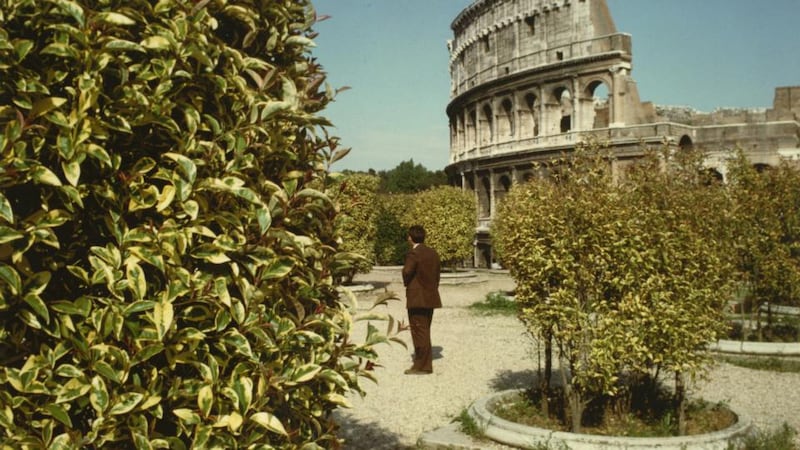Approaching the Landscape
Rua Red, Tallaght, Dublin
****

This exhibition is the end result of the second instalment of Rua Red's Young Curators Project. Three fledgling curators were selected from open submission late last year. Matthew Fitzgerald and Rachael Kennedy are IT students of creative digital media, while Sarah Usher is a graduate of design visual communications at DIT, who also earned an MA in visual and material culture in Edinburgh. They devised the exhibition with artist-facilitator Jane Fogarty.
They visited several group studio complexes in Dublin, engaging with artists and then inviting five to take part. In a way, Usher went further, contributing a work of her own, Reimagined Histories: A Walking Tour of Tallaght. Applying a variation of the cut-up method made famous by William Burroughs to a printout of a walking tour on the South Dublin History website, she concocts a culturally and topographically jumbled tour of the culturally and topographically jumbled area. It's good.
Depending on how you define its boundaries, Tallaght’s population is somewhere between 70,000 and 100,000 people, which makes it a formidable civic entity. Add its geographical character, a mixture of urban, suburban and rural terrain, bounded by city, mountains and agricultural countryside, and you have a fruitful context within which to consider the art of the contemporary landscape from the point of view of making art and looking at art.
There’s no ignoring the immediate context, as Rua Red is located next to the Luas stop, right beside the retail cathedral of the Square with its shops, cafes, restaurants and cinemas, close to apartment blocks, a hotel and not far from the hospital.
What Conor Mary Foy brings to mind with his two short video pieces, though, is the ominous nature of the nearby slopes with their gloomy conifer plantations and the Hellfire Club. Talisman has a figure in a tall spiked hat engaging in an unexplained ritual with a scrap of scarlet fabric. The Seekers is a strange, looped work in which two hooded figures wielding wooden clubs languidly pursue their human prey. Without any violence as such, it's charged with menace, has an allegorical simplicity and impact and works superbly on many levels.
Jason Deans prompts us to reconsider easy dismissal of electricity pylons as eyesores and worse by crafting rather beautiful sculptural versions in elder wood and twine, comfortingly natural materials that domesticate the forms and allow us to see them as visually elegant.
Lili Heller uses surrealist pictorial devices in paintings and drawings that may reflect either environmental oddity or subjective psychological states, or a mixture of the two, always with a slight edge. Margaret Corcoran looks at our tendency to fritter away and disassemble the sublime landscape and replace it with concrete.
More abstract but just as compelling, Niall de Buitléar’s small paintings, built from intricate concentric patterns, are geometric but also suggestive of organic processes. They equate to the world outside: complex and orderly but also contingent and unpredictable. Their handmade precision makes them visually fascinating. You could quite happily live with any one of them and never tire of it.
A job well done, then? As far as it goes, yes. But as regards presentation as opposed to substance, Approaching the Landscape doesn't address its context. For example, several versions of a poster for the show obscure the visual content in favour of blocks of text. It suggests a lack of faith in the enterprise. Why not isolate and reproduce an image by Foy or de Buitléar, for example, give it prominence, put it out there in the Square, suitably and provocatively captioned, to draw in your audience?
The Young Curators Project speaks of “demystifying the curatorial process”. That should mean having individuals with a background in visual communications approaching it critically and trying new approaches, because the curatorial process as it exists is deeply committed to mystification. Get drawn into it and you’ll find yourself speaking an opaque language that sounds like a mix of critical theory and management-speak. We need curators who will break the mould, not join the club.
[ ruared.ieOpens in new window ]
Luigi Ghirri (Gallery 1)
Shapes from Life – Aleana Egan (Gallery 2)
Douglas Hyde Gallery, Dublin
****
Luigi Ghirri (1942-1992) was a celebrated Italian photographic artist. Have a look at the cross-section of his works on view here and you’ll get a sense of where he was coming from. In his cool images there’s a certain scepticism about photography, an ironic distance. He likes incorporating photographs of photographic reproductions, such as advertising posters, or scraps of such images discarded in the landscape, to underline the nature of the photograph as a construct and not an unmediated truth.
Besides using such material as cinema posters or empty advertising hoardings, he can be more subtle, as in his photograph of the window display of an art supplies shop: we see a model hand, presumably manufactured as an artist’s reference, next to a box of pastels. It’s an effective image of countless images in the making. Nothing from what was probably his most interesting project, his photographs of Giorgio Morandi’s studio, features in this show, but it is well worth seeing.
Its adjunct, in Gallery 2, is an installation by Aleana Egan, who usually roots her abstract, structural sculptures in specific sources of inspiration. This time, a canopy suspended over a low, horizontal form, largely copper, references a painting by Margaret Clarke, The Dressmaker, also exhibited, and Jospeh Mankiewicz's 1949 film A Letter to Three Wives in which the suspense lies in the identity of the husband with whom the protagonist has absconded. As with Howard Hodgkins's paintings, the correlation between the work and its sources is subjective and indirect.











